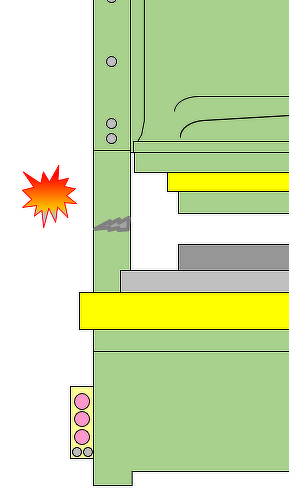
What are "Press Forming Capacity Limitations"?
There are many press forming capacity limitations.
Press forming cannot be discussed by merely stating 'the forming load is xxx tons."
The following represent the primary forming capacity limitations that need to be considered:
・ Pressure capacity limitations
・ Torque capacity limitations
・ Work capacity limitations
・ Off-center loading limitations
・ Allowable concentrated load limitations
・ Intermittent stroke limitations
・ SPM limitations
・ Material feed limitations
You are probably thinking, 'I didn't know there were so many limitations!'
However, this just serves to show just how severe press forming work is on the dies and the presses themselves.
This article discusses two forming capacity limitations--'pressure capacity limitations' and 'allowable concentrated load limitations.'
What are 'Pressure Capacity Limitations'?
The nominal capacity of a press is reflected in its designation--in the case of a ●●-ton press, it would be "●● tons"--but you should avoid using a press at the very limit of its nominal capacity.
The load used for the forming that is actually being performed is called the working load, but the working load can fluctuate and not remain a constant value.
This is because the working load can exceed the anticipated load for the following reasons:
・Material thicknesses
・Material hardness variations
・Wear on die cutting surfaces
・Variations in the die lubrication conditions
・The die height setting, etc.
When selecting a press, we recommend selecting one with sufficient excess capacity to compensate for the above factors that can affect the working energy.
In particular, it is said that the most severe press metalforming work is blanking, where impact loads are created by the sudden release of energy (referred to as 'breakthrough'; see the following video clip).
In order to work safely and extend the life of your dies, we recommend the rule of thumb of selecting and utilizing a press at a working load that is 70% of its nominal capacity.
For example:
If the work load is 1400 kN:
Select a press with a capacity of 2000 kN or higher
What are "Allowable Concentrated Load Limitations"?
If high loads are exerted on a small die, it results in concentrated loads being applied on the slide and bolster, and this will cause a high degree of press deflection.
Such usage can lead to poor product accuracy, indentations in the slide and bolster, and cracks in the press frame.

Frame Crack Illustration Note: The size of the crack is exaggerated.
Presses are designed based on the assumption that the load will be evenly distributed in the center of the press within an area that is 60% of the total die space area.
Accordingly, if the die contact area is less than 60% of the die space area, it will be necessary for you to take measures to limit the working load.
And finally...
Although bigger is better when it comes to the nominal press capacity, it doesn't necessarily mean that a large die space area is better than a small die space area.
In order to use a press safely, it is extremely important to pick the press best suited for the forming application.
